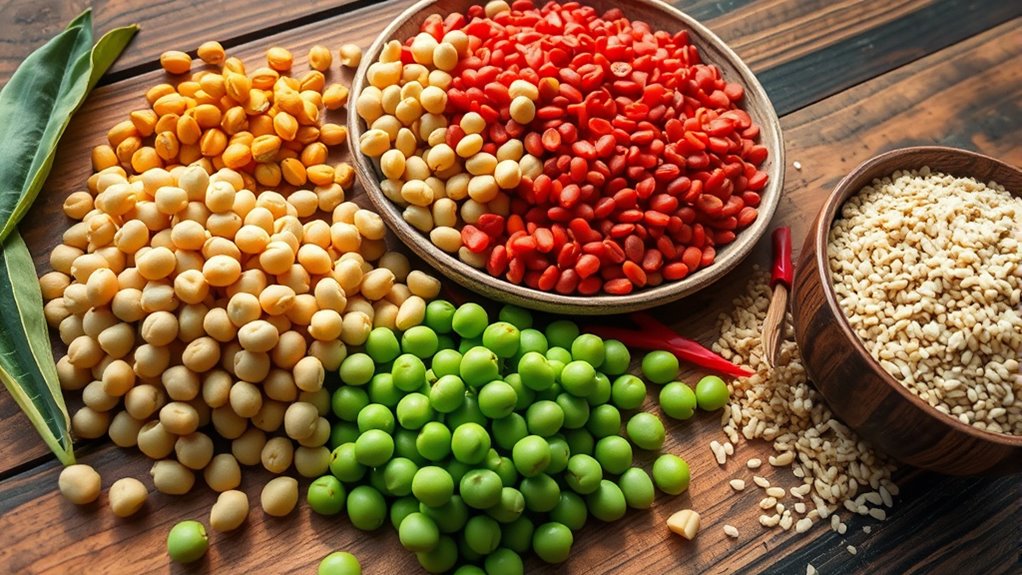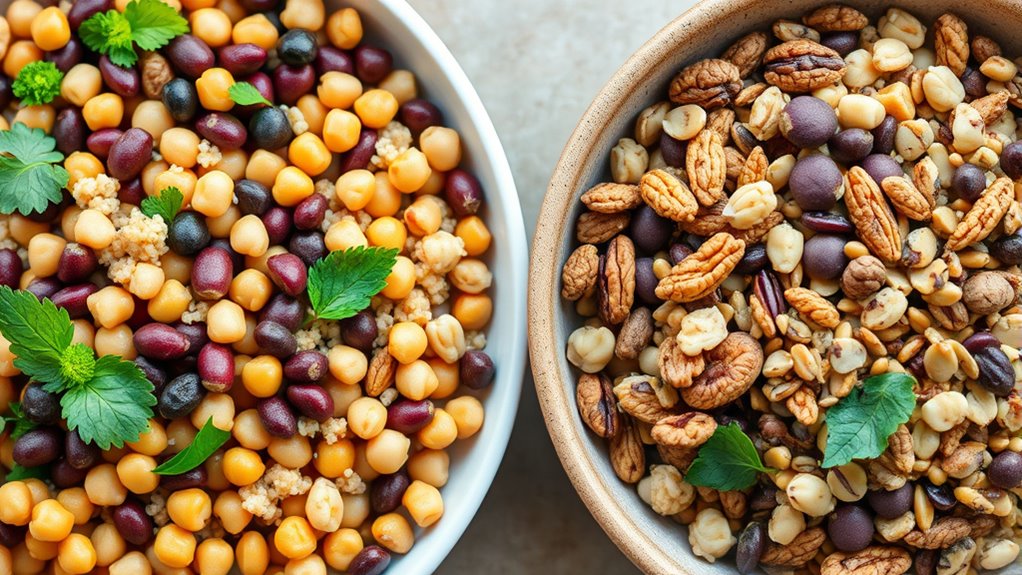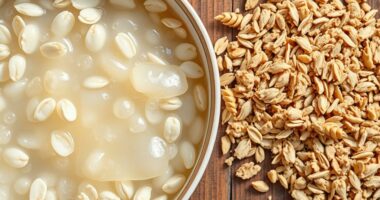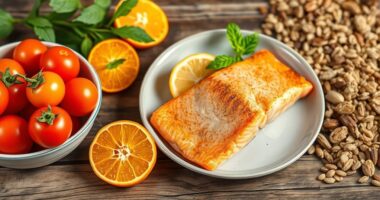Plant-based proteins are either complete or incomplete. Complete proteins contain all essential amino acids your body needs and include sources like soy and quinoa. Incomplete proteins lack one or more of these amino acids, which means you might need to combine different plant foods, like grains and legumes, to get a full amino acid profile. Understanding these differences can help you plan a more balanced diet — and there’s more to discover on how to optimize your plant-based protein intake.
Key Takeaways
- Complete plant proteins contain all essential amino acids; incomplete ones lack at least one, requiring food combining for nutritional balance.
- Soy and quinoa are examples of naturally complete plant proteins, simplifying diet planning.
- Many plant proteins, like grains and legumes, are incomplete and benefit from pairing to improve amino acid profiles.
- Protein digestibility varies among plant sources and impacts the body’s ability to utilize amino acids effectively.
- Diversifying plant-based protein sources enhances nutrient intake and compensates for incomplete amino acid profiles.

Plant-based protein has gained popularity as a sustainable and healthy alternative to animal-derived sources. If you’re exploring plant-based diets or trying to boost your protein intake, understanding the concept of nutritional completeness is essential. Not all plant proteins are created equal, especially when it comes to amino acid profiles. Amino acids are the building blocks of protein, and your body needs a complete set to function as effectively as possible. Some plant proteins are incomplete, meaning they lack one or more essential amino acids, while others are complete, providing all the amino acids your body requires.
Understanding plant proteins and amino acids is key to building a complete, nutritious plant-based diet.
When you focus on plant-based proteins, you’ll notice that many are incomplete. For example, grains like rice and wheat are rich in certain amino acids but lack others, such as lysine. Legumes, like beans and lentils, are excellent sources of lysine but often fall short on methionine. This incomplete profile can be a concern if you rely solely on one type of plant protein, because it may lead to nutritional gaps. That’s why combining different plant proteins is a common strategy. By eating a variety of sources, you can complement amino acid profiles—pairing grains with legumes, for instance—ensures you get a full spectrum of amino acids, achieving nutritional completeness.
However, some plant-based proteins are naturally complete. Soy and quinoa are notable examples. They contain all essential amino acids in sufficient amounts, so they can stand alone as reliable sources of dietary protein. This makes them especially valuable if you’re aiming for a plant-based diet that doesn’t require constant food combining. Still, it’s important to understand that even complete plant proteins might have different digestibility rates compared to animal proteins. This doesn’t mean they’re less healthy, but it’s a factor to think about when planning your meals to meet your protein needs. Additionally, recent research highlights the importance of considering protein digestibility when evaluating plant-based sources, as it directly impacts how well your body can utilize the amino acids provided.
Another aspect to think about is that plant proteins often come with additional nutrients, like fiber, vitamins, and minerals, which contribute to overall health. Yet, because of their varying amino acid profiles, it’s wise to diversify your plant protein sources rather than relying on just one. Doing so not only helps you get all essential amino acids but also supports a balanced diet rich in other nutrients. So, whether you choose complete options like soy or combine incomplete sources, understanding amino acid profiles and nutritional completeness empowers you to make smarter, more effective choices for your health and sustainability goals.
Frequently Asked Questions
Are Plant Proteins Suitable for Athletes and Bodybuilders?
You might wonder if plant proteins suit athletes and bodybuilders, but plant-based myths often suggest they aren’t enough. In sports nutrition, you can absolutely thrive on plant proteins by combining different sources to get all essential amino acids. With proper planning, plant proteins provide the nutrients you need for muscle growth and recovery. So, yes, plant-based diets can support your training goals effectively.
How Do Plant-Based Proteins Compare in Digestibility to Animal Proteins?
When comparing plant-based proteins to animal proteins, you’ll find that plant proteins often have lower amino acid bioavailability and digestibility scores. This means your body may absorb fewer nutrients from plant sources. However, combining different plant proteins can improve digestibility and amino acid profiles. So, while animal proteins tend to be more digestible overall, careful selection and pairing of plant proteins can help you meet your nutritional needs effectively.
Can Incomplete Plant Proteins Meet All Essential Amino Acid Needs?
You can meet all your essential amino acid needs with incomplete plant proteins by combining different sources. This prevents amino acid deficiency and guarantees your body gets a complete protein profile. With plant protein supplementation, you mix grains and legumes, which complement each other’s amino acids. This strategy allows you to enjoy plant-based diets without worrying about missing essential amino acids, making it a flexible and nutritious choice.
Are Plant-Based Proteins More Sustainable Than Animal-Based Sources?
Think plant-based proteins are less sustainable? Think again. Their environmental impact is often lower because they require less water, land, and produce fewer emissions. Plus, supporting crop diversity helps prevent monocultures and boosts resilience. So, by choosing plant-based sources, you’re actively reducing your carbon footprint and promoting eco-friendly farming. Ironically, what seems less hearty on the plate actually offers a more sustainable future for our planet.
What Are the Best Plant Protein Combinations for Complete Amino Acid Profiles?
You want to maximize plant protein intake by creating complete amino acid profiles. To do this, focus on legume pairing, like beans with rice or lentils with wheat, and grain blending, such as quinoa with chickpeas or oats with peanut butter. These combinations provide all essential amino acids, making your plant-based meals more balanced. Incorporate variety to guarantee you’re getting the full spectrum of amino acids your body needs.
Conclusion
By now, you see that combining plant-based sources like beans and rice can provide complete protein, just like a balanced meal. Imagine someone switching to a vegetarian diet and noticing improved energy and digestion within weeks. Whether you’re vegan or just exploring plant proteins, mixing different sources guarantees you get all essential amino acids. Start experimenting today—your body will thank you for the variety and balance!









